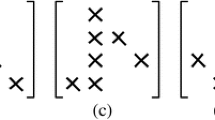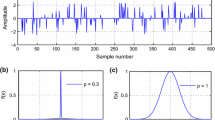Abstract
In this paper, we address the problem of channel estimation and signal detection for orthogonal frequency division multiplexing (OFDM) system with multiple receive antennas. The received signal can be denoted as a trilinear model, and then a trilinear decomposition-based channel estimation and signal detection algorithm is proposed. Scalar ambiguity which is inherent in the blind algorithms can be easily resolved by insertion fewer pilots in the proposed algorithm. Compared with conventional subspace approaches, the proposed algorithm has improved estimation performance, and the signal detection performance of the proposed algorithm is very close to non-blind minimum mean square error (MMSE) receiver. Furthermore, our proposed algorithm works well in the presence/absence of virtual carriers, and it does not require knowledge of statistical characteristics. Simulation results illustrate performance of the algorithm.
Similar content being viewed by others
References
Hara S., Mouri M., Okada M., Morinaga N. (1995) Transmission performance analysis of multi-carrier modulation in frequency selective fast Rayleigh fading channel. Wireless Personal Communications 2(4): 335–356
van Nee R., Awater G., Morikura M., Takanashi H., Webster M., Halford K. W. (1999) New high rate wireless LAN standards. IEEE Communications Magazine 37(12): 82–88
Le K. N. (2010) BER of OFDM in Rayleigh fading environments with selective diversity. Wireless Communications and Mobile Computing 10(2): 306–311
Le K. N. (2009) Performance bounds on BER of OFDMA with pulse shaping and maximal ratio combining diversity. European Transactions on Telecommunications 20(5): 487–493
Le K. N. (2008) Bounds on inter-carrier interference power of OFDM in a Gaussian scattering channel. Wireless Personal Communications 47(3): 355–362
Zhang X., Feng B., Xu D. (2008) Blind joint symbol detection and DOA estimation for OFDM system with antenna array. Wireless Personal Communications 46(3): 371–383
Zhang X., Gao X., Wang D., Xu D. (2010) Blind carrier frequency offset estimation for OFDM system with multiple antennas using multiple-invariance properties. Wireless Personal Communications 53(4): 603–612
Zhang, X., Gao, X., & Xu, D. (2010, March). Novel blind carrier frequency offset estimation for OFDM system with multiple antennas. IEEE Transactions on Wireless Communications, 9(3), 881–885.
Sari H., Karam G., Jeanclaude I. (1995) Transmission techniques for digital terrestrial TV broadcasting. IEEE Communications Magazine 33(2): 100–109
Li Y., Cimini L. J. Jr., Sollenberger N. R. (1998) Robust channel estimation for OFDM systems with rapid dispersive fading channels. IEEE Transactions on Communications 46(7): 902–915
Lee S., Kwak K., Kim J., Hong D. (2008) Channel estimation approach with variable pilot density to mitigate interference over time-selective cellular OFDM systems. IEEE Transactions on Wireless Communications 7(7): 2694–2704
Coleri S., Ergen M., Puri A., Bahai A. (2002) Channel estimation techniques based on pilot arrangement in OFDM systems. IEEE Transaction on Broadcasting 48(3): 223–229
Choi J.-W., Lee Y.-H. (2005) Optimum pilot pattern for channel estimation in OFDM systems. IEEE Transactions on Wireless Communications 4(5): 2083–2088
Song S., Singer A. C. (2007) Pilot-aided OFDM channel estimation in the presence of the guard band. IEEE Transactions on Communications 55(8): 1459–1465
Li C., Roy S. (2003) Subspace-based blind channel estimation for OFDM by exploiting virtual carriers. IEEE Transactions on Wireless Communications 2(1): 141–150
Heath R. W. Jr., Giannakis G. B. (1999) Exploiting input cyclostationarity for blind channel identification in OFDM systems. IEEE Transactions on Signal Processing 47: 848–856
Muquet B., de Courville M., Duhamel P. (2002) Subspace-based blind and semi-blind channel estimation for OFDM systems. IEEE Transactions on Signal Processing 50(7): 1699–1712
Zhuang, X., Ding, Z., & Swindlehurst, A. L. (2000). A statistical subspace method for blind channel identification in OFDM communications. In Proceedings of the international conference on acoustics, speech, and signal processing (vol. 5, pp. 2493–2496). Istanbul, Turkey Jun. 5–9.
Cai, X., & Akansu, A. N. (2000). A subspace method for blind channel identification in OFDM systems. In Proceedings of the international conference on communications (pp. 929–933). New Orleans, LA, USA, Jun. 18–22.
Zhou S., Giannakis G. B. (2001) Finite-alphabet based channel estimation for OFDM and related multicarrier systems. IEEE Transactions on Communications 49(8): 1402–1414
Hutter, A., Hammerschmidt, J. S., de Carvalho, E., & Cioffi, J. M. (2000). Receive diversity for mobile OFDM systems. In Proceedings of the IEEE wireless communications, network conference (pp. 707–712). Chicago, IL, USA, Sept. 23–28.
Zheng Z.-W., Huang D. (2007) Robust plateau removed synchronization techniques for multiple-antenna OFDM-based DVB-H receivers. IEEE Transactions on Consumer Electronics 53(4): 1281–1287
Wang H., Lin Y., Chen B. (2003) Data-efficient blind OFDM channel estimation using receiver diversity. IEEE Transactions on Signal Processing 51(10): 2613–2623
Roy S., Li C. (2002) A subspace blind channel estimation method for OFDM systems without cyclic prefix. IEEE Transactions on Wireless Communications 1(4): 572–579
Kruskal J. B. (1977) Three-way arrays: rank and uniqueness of trilinear decompositions with application to arithmetic complexity and statistics. Linear Algebra Applications 18: 95–138
De Lathauwer L., De B., Vandewalle M. J. (2004) Computation of the canonical decomposition by means of a simultaneous generalized schur decomposition. SIAM Journal of Matrix Analysis and Applications 26(2): 295–327
De Lathauwer L. (2006) A link between the canonical decomposition in multi-linear algebra and simultaneous matrix diagonalization. SIAM Journal of Matrix Analysis and Applications 28(3): 642–666
Sidiropoulos N. D., Giannakis G. B., Bro R. (2000) Blind PARAFAC receivers for DS-CDMA systems. IEEE Transactions on Signal Processing 48(3): 810–823
Sidiropoulos N. D., Dimic G. Z. (2001) Blind multiuser detection in W-CDMA systems with large delay spread. IEEE Signal Processing Letters 8(3): 87–89
Sidiropoulos N. D., Bro R., Giannakis G. B. (2000) Parallel factor analysis in sensor array processing. IEEE Transaction on Signal Processing 48(8): 2377–2388
Rong Y., Vorobyov S. A., Gershman A. B., Sidiropoulos N. D. (2005) Blind spatial signature estimation via time-varying user power loading and parallel factor analysis. IEEE Transaction Signal Processing 53(5): 697–1710
Zhang, X., & Xu, D. (2007). Blind PARAFAC signal detection for polarization sensitive array. EURASIP Journal of Advances in Signal Processing, vol. 2007, pp. 1–7. Article ID 12025, doi:10.1155/2007/12025.
Zhang, X., Shi, Y., & Xu, D. (2008). Novel blind joint direction of arrival and polarization estimation for polarization-sensitive uniform circular array. In Progress in electromagnetics research, PIER 86 (pp. 19–37).
de Almeida A. L. F., Favier G., Mota J. C. M. (2007) PARAFAC-based unified tensor modeling for wireless communication systems with application to blind multiuser equalization. Signal Processing 87: 337–351
De Baynast, A., De Lathauwer, L., & Aazhang, B. (2003, October). Blind PARAFAC receivers for multiple access-multiple antenna systems. In IEEE 58th vehicular technology conference (pp. 1128–1132).
Yu, Y., & Petropulu, A. P. (2006, May). PARAFAC based blind estimation of MIMO systems with possibly more inputs than outputs. In IEEE international conference on acoustics, speech and signal processing (pp. 133–136).
de Almeida, A. L. F., Favier, G., & Mota J. C. M. (2007). A trilinear decomposition approach for Space-Time-Frequency multiple-access wireless systems. In IEEE 8th workshop on signal processing advances in wireless communications, 2007. SPAWC.
Vorobyov S. A., Rong Y., Sidiropoulos N. D., Gershman A. B. (2005) Robust iterative fitting of multilinear models. IEEE Transactions on Signal Processing 53(8): 2678–2689
Tomasi G., Bro R. (2006) A comparison of algorithms for fitting the PARAFAC model. Computational Statistics & Data Analysis 50(7): 1700–1734
Sidiropoulos N. D., Liu X. (2001) Identifiability results for blind beamforming in incoherent multipath with small delay spread. IEEE Transactions on Signal Processing 49(1): 228–236
Papadias C. B., Huang H. (2001) Linear space-time multiuser detection for multipath CDMA channels. IEEE Journal on Selected Areas in Communications 19(2): 254–265
Hamouda, W., & McLane, P. J. (2002, September). Performance of space-time MMSE adaptive receivers in DS-CDMA systems using FEC coding in flat fast-fading channels. In Proceedings of the IEEE vehicular technology conference, Vancouver, BC, Canada (pp. 1049–1056).
Author information
Authors and Affiliations
Corresponding author
Rights and permissions
About this article
Cite this article
Zhang, X., Wu, H., Li, J. et al. Semiblind Channel Estimation and Signal Detection for OFDM System with Receiver Diversity. Wireless Pers Commun 66, 101–115 (2012). https://doi.org/10.1007/s11277-011-0328-1
Published:
Issue Date:
DOI: https://doi.org/10.1007/s11277-011-0328-1




